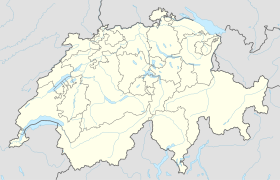Chésopelloz
| Chésopelloz | ||
|---|---|---|
| State : |
|
|
| Canton : |
|
|
| District : | Saane | |
| Municipality : | Corminboeuf | |
| Postal code : | 1720 | |
| former BFS no. : | 2179 | |
| Coordinates : | 572 498 / 184 071 | |
| Height : | 620 m above sea level M. | |
| Area : | 1.67 km² | |
| Residents: | 123 (December 31, 2015) | |
| Population density : | 74 inhabitants per km² | |
| Website: | www.corminboeuf.ch | |
|
Chapel of Ortisei in Chésopelloz |
||
| map | ||
|
|
||
Chésopelloz ( Friborg Patois ) was a municipality in the District de la Sarine (German: Saanebezirk) in the canton of Friborg in Switzerland until December 31, 2016 . On January 1, 2017, it merged with Corminboeuf .
geography
Chésopelloz lies at 620 m above sea level. M. , 6 km west of the canton capital Friborg (beeline). The farming village extends on the western slope of the Sonnaz , east of the Piamont , in the Freiburg Central Plateau .
The area of the 1.7 km² municipal area includes a section of the Molasse Heights between the Broye plain and the Saane valley . The area is crossed from southwest to northeast by the Sonnaz basin; the northern border runs along the left side stream Ruisseau du Moulin . In the west, the municipality extends to the edge of the forest of the Piamont , where at 700 m above sea level. M. the highest point of Chésopelloz is reached. To the southeast of the Sonnaz, the area extends into the forest of Verdilloud and the heights of Corminboeuf. In 1997, 2% of the municipal area was in settlements, 26% in forests and woodlands, 71% in agriculture and a little less than 1% was unproductive land.
Chésopelloz includes the hamlet of Le Haut ( 622 m above sea level ) on the eastern slope of the Sonnaz valley and several individual farms. Neighboring municipalities to Chésopelloz are Belfaux , Corminboeuf , Avry , Noréaz and Ponthaux .
population
With 123 inhabitants (as of December 31, 2015), Chésopelloz was one of the smallest communities in the canton of Friborg. Of the residents, 82.6% are French-speaking, 13.8% German-speaking and 1.8% speak Italian (as of 2000). The population of Chésopelloz was 118 in 1850 and 152 in 1900. In the course of the 20th century, the population decreased by almost 60% to 65 people due to strong emigration by 1980. Since then, the population has grown rapidly again.
economy
Chésopelloz was a predominantly agricultural village until the second half of the 20th century . Even today, the have farming , the fruit production , the dairy industry and animal husbandry an important role in the employment structure of the population. Some other jobs are available in local small businesses and in the service sector. The water power of the Sonnaz was previously used to operate a mill. In the last few decades the village has also developed into a residential community. Many workers are therefore commuters who mainly work in the Freiburg region.
traffic
The municipality is located off the major thoroughfares, the main access is from Corminboeuf. The closest connection to the A12 motorway (Bern-Vevey) is around 6 km from the town center. The village is connected to the public transport network by a bus from the Transports publics Fribourgeois , which runs from Freiburg to Chésopelloz.
history
The place was first mentioned in a document in 1229 under the name Chissapenlo . Later the names Cheseaupenlo (1406), Chesaupello (1445) and Chesopelo (1668) appeared. The place name is made up of the old French word chésal (small house) and the personal name Pennilo and means house of Pennilo .
Chésopelloz came in 1317 from the Lords of Estavayer through an exchange to the Abbey of Hauterive . Through purchase, the village came under the rule of Freiburg at the latest in 1442 and was assigned to the Old Landscape (Spitalpanner). After the collapse of the Ancien Régime (1798), Chésopelloz belonged to the Friborg district during the Helvetic and the following period, before it was incorporated into the Saane district in 1848 with the new cantonal constitution.
A merger of Granges-Paccot , Givisiez, Corminboeuf and Chésopelloz was in preparation until 2014 under the name "2C2G" - the new place should be called Englisbourg (after the Englisberg family, who worked in all four places). This failed because of the rejection by the citizens of Granges-Paccot.
Attractions
The Ulrich chapel dates from 1683; Chésopelloz belongs to the parish of Belfaux .
Web links
- Official website of the municipality of Chésopolloz (French)
- Marianne Rolle / EM: Chésopelloz. In: Historical Lexicon of Switzerland .
Individual evidence
- ↑ Report in FN
- ↑ http://www.rts.ch/info/regions/fribourg/4880522-quatre-communes-fribourgeoises-vers-une-fusion-sous-le-nom-d-englisbourg.html RTS (in French)
- ↑ Webpage of the Fusion 2C2G ( Memento of the original from February 11, 2013 in the Internet Archive ) Info: The archive link was inserted automatically and has not yet been checked. Please check the original and archive link according to the instructions and then remove this notice.
- ↑ http://www.srf.ch/news/regional/bern-freiburg-wallis/fusion-gescheitert-keine-grossgemeinde-neben-freiburg






